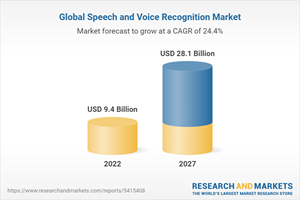Global Speech and Voice Recognition Market (2022 to 2027) - APAC is the Fastest-growing Region in the Industry

Global Speech and Voice Recognition Market

Dublin, July 15, 2022 (GLOBE NEWSWIRE) -- The "Global Speech and Voice Recognition Market by Deployment Mode (On-Cloud, On-Premises/Embedded), Technology (Speech Recognition, Voice Recognition), Vertical, and Geography (Americas, Europe, Asia Pacific, Rest of the World) - Forecast to 2027" report has been added to ResearchAndMarkets.com's offering.
The global speech and voice recognition market is projected to grow from USD 9.4 Billion in 2022 to USD 28.1 Billion by 2027, it is expected to grow at a CAGR of 24.4% from 2022 to 2027.
Extensive penetration of speech and voice recognition technologies in smart appliances
The demand for smart homes and smart appliances is increasing owing to various factors, including the growing internet penetration, rapid technological advancements, and increased focus on home automation to achieve security and convenience. The COVID-19 pandemic has also prompted the use of smart devices and appliances in almost every aspect of daily life. People are encouraged to work from home, leading to high demand for speech and voice recognition technology-based products.
Manufacturers of smart appliances are adding the voice recognition feature to their products to enable users to control all their appliances from a single speech and voice recognition technology-based product. The demand for products such as Alexa, Cortana, and Siri, has increased significantly. Samsung Electronics (South Korea), a leading manufacturer of smart appliances, has introduced the Smart Things app with inbuilt voice recognition technology to allow users to control all the appliances in the house with single voice commands.
Several other manufacturers, such as Whirlpool and Philips, have similar voice-activated control solutions. As consumers move toward automation, the demand for speech and voice recognition technology-based products is also likely to increase.
APAC is the fastest-growing region in the speech and voice recognition market
The speech and voice recognition market in Asia Pacific is expected to grow at the highest CAGR from 2022 to 2027 owing to technological advancements, improved awareness regarding the benefits of these technologies among the masses, and the low cost of speech and voice recognition devices. China, Japan, and India are the key countries in the Asia Pacific region for the speech and voice recognition market. Baidu (China) and iFlytek (China) are the top two companies in the region operating in the speech and recognition market.
Key Topics Covered:
1. Introduction
2. Research Methodology
3. Executive Summary
4. Premium Insights
5. Market Overview
5.1. Introduction
5.2. Market Dynamics
5.2.1. Drivers
5.2.2. Restraints
5.2.3. Opportunities
5.2.4. Challenges
5.3. Value Chain Analysis
5.4. Porter's Five Forces Analysis
5.5. Average Selling Pricing Analysis
5.6. Trade Analysis
5.7. Ecosystem Analysis
5.8. Case Study Analysis
5.9. Patent Analysis
5.10. Technology Analysis
5.11. Codes and Standards
5.12. Tariff Analysis
5.13. Regulatory Bodies, Government Agencies & Other Organizations
5.14. Revenue Shift
5.15. Key Conferences and Events in 2022-2023
5.16. Key Stakeholder and Buying and/or Buying Criteria
5.16.1. Key Stakeholders in Buying Process
5.16.2. Buying Criteria
6. Speech and Voice Recognition Market, by Delivery Method
6.1. Introduction
6.2. Artificial Intelligence-based
6.3. Non-Artificial Intelligence-based
7. Market, by Technology
7.1. Introduction
7.2. Voice Recognition
7.2.1. Speaker Identification
7.2.2. Speaker Verification
7.3. Speech Recognition
7.3.1. Multilingual Speech Recognition to Increase Scope of Applications
7.3.2. Automatic Speech Recognition
7.3.3. Text-To-Speech
8. Speech and Voice Recognition Market, by Deployment Mode
8.1. Introduction
8.2. on Cloud
8.3. On-Premises/Embedded
9. Market, by Vertical
9.1. Introduction
9.2. Automotive
9.3. Enterprises
9.4. Consumer
9.5. Banking, Financial Services and Insurance (BFSI)
9.6. Government
9.7. Retail
9.8. Healthcare
9.9. Military
9.10. Legal
9.11. Education
9.12. Others
10. Speech and Voice Recognition Market, by Geography
10.1. Introduction
10.2. Americas
10.2.1. US
10.2.2. Canada
10.2.3. Rest of Americas
10.3. Europe
10.3.1. UK
10.3.2. Germany
10.3.3. France
10.3.4. Rest of Europe
10.4. APAC
10.4.1. Japan
10.4.2. China
10.4.3. India
10.4.4. Rest of APAC
10.5. Rest of the World (RoW)
10.5.1. Middle East
10.5.2. Africa
11. Competitive Landscape
11.1. Introduction
11.2. Top 5 Company Revenue Analysis
11.3. Strategies Adopted by Key Players
11.4. Market Share Analysis
11.5. Company Evaluation Matrix
11.5.1. Star
11.5.2. Pervasive
11.5.3. Emerging Leaders
11.6. Strength of Product Portfolio
11.7. Business Strategy Excellence
11.8. Small and Medium Enterprises (SME) Evaluation Quadrant
11.8.1. Progressive Companies
11.8.2. Responsive Companies
11.8.3. Dynamic Companies
11.8.4. Starting Blocks
11.9. Competitive Situation and Trends
11.10. Competitive Benchmarking
12. Company Profiles
12.1. Introduction
12.2. Key Companies
12.2.1. Hexagon
12.2.2. Faro Technologies
12.2.3. Nikon Metrology
12.2.4. Carl Zeiss
12.2.5. Jenoptik
12.2.6. Creaform
12.2.7. KLA-Tencor
12.2.8. Renishaw
12.2.9. GOM
12.2.10. Mitutoyo Corporation
12.3. Other Players
12.3.1. Precision Products
12.3.2. Carmar Accuracy
12.3.3. Baker Hughes
12.3.4. CyberOptics
12.3.5. Cairnhill Metrology
12.3.6. ATT Metrology Services
12.3.7. SGS Group
12.3.8. TriMet Group
12.3.9. Automated Precision
12.3.10. Applied Materials
12.3.11. Perceptron
12.3.12. JLM Advanced Technical Services
12.3.13. Intertek
12.3.14. Bruker
12.3.15. Metrologic Group
12.3.16. Speechmatics
12.3.17. DeepGram
12.3.18. Assembly.ai
12.3.19. Verbit
12.3.20. VoiceITT
12.3.21. Otter.ai
12.3.22. Voicegain
12.3.23. Sensory
12.3.24. rev.com
13. Appendix
For more information about this report visit https://www.researchandmarkets.com/r/sk32ie
Attachment
CONTACT: CONTACT: ResearchAndMarkets.com Laura Wood, Senior Press Manager press@researchandmarkets.com For E.S.T Office Hours Call 1-917-300-0470 For U.S./CAN Toll Free Call 1-800-526-8630 For GMT Office Hours Call +353-1-416-8900


 Yahoo Finance
Yahoo Finance 
